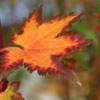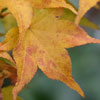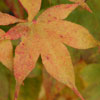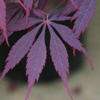| ACER
palmatum
'Happy Corallinum'
This is the name I received this one under, but playing by the nomenclature rules, it's not allowed! It will therefore be "properly" named in due course I'm sure. Of course the name was intended to allude to the fact that this is stronger growing, more amenable version of the well known 'Corallinum', with its characteristic bright pink spring growth. |
||
|
|
||
| ACER palmatum
'Haru iro'
Another of my more recent acquisitions from the USA which is poorly documented in both literature and on the web. However, from my experience with it, I would describe it as extremely slow growing. The leaves are large and rounded enough to indicate that it is a hybrid with A. shirasawanum. The colour is quite remarkable too, though not easy to describe, being a glorious mixture of orange-red and copper, with some green tints thrown in for good luck (according to light levels). It's a shame that it is proving so slow and difficult to propagate as I love the colour. Nevertheless, it is unlikely that we will propagate it. |
||
|
|
||
| ACER
palmatum 'Heffner's Red' When compared to the more familiar 'Bloodgood', this essentially purple leaved cultivar has slightly smaller, more reddish purple leaves which hold their colour well through the summer before turning bright red in autumn. It develops a generally smaller, more compact habit. I think it's a rather good cultivar. |
||
|
|
||
 |
ACER palmatum
'Herbstfeuer' Although given cultivar status under Acer palmatum, it is likely that this one is actually a hybrid with Acer circinatum. This is evident in the larger leaves, with more rounded lobes. A densely branched and upright grower with rich dark green leaves. However, the German name translates to "Autumn Fire" which aptly describes its most dramatic feature, the wonderful fiery autumn leaf colours. |
|
|
|
||
 |
ACER palmatum
'Higasa yama'
A tall, almost columnar twiggy tree to 7m. The leaves when they first emerge are bright red and curiously contorted. As they mature, they develop a symmetrical white and pink margin. Best in a pot or on poor soil as the variegation can be lost if allowed to grow too strongly. This is not one that we will be propagating in the future. 4-5m |
|
|
|
||
 |
ACER palmatum
'H˘gyoku'
I am delighted that we can now add this one to our collection. It is distinctive at any time of the year. The leaves are not particularly large, but the chubby lobes make them look very solid. They are a simple green for much of the year before developing vivid shades of gold and orange. A compact and tidy, rather upright habit and attractive silvery bark help to make it stand out in the collection. 3-4m |
|
|
|
||
 |
ACER palmatum
'Ichigy˘ji' This Japanese selection was actually introduced in 1911. It is outstanding for autumn colour and attracts a lot of comments. The large leaf is the same shape as the better known 'Osakasuki' but the autumn colours are usually vibrant orange-yellows. This can vary with the season and the conditions; indeed one year ours was scarlet! Distinctive angular habit, giving a comparatively broad habit to 3-4m tall. |
|
|
|
||
| ACER palmatum
'Inazuma'
The translation of the name, "the thunderer" gives a feel of this plant; with rich, deep purple foliage maturing to dark purple-tinged green. The leaves are deeply divided though not as a dissectum. Scarlet autumn colours light up this hardy, vigorous small tree, to 6m or potentially more. |
||
|
|
||
| ACER palmatum
'Jane' This Dutch cultivar was selected primarily for its long-lasting bright yellow-orange autumn colours. The comparatively small green leaves are highlighted by red leaf stalks and shoots. It develops into a broad crowned small, freely branching small tree. 3m |
||
|
|
||
| ACER palmatum
'Japanese
Sunrise' The same principle as the better known 'Sangokaku', the fantastic winter bark is a lighter shade of coral red on the upper exposed side of the twig, and yellow orange on the lower sheltered side, which is most effective, particularly when planted to catch the low winter sun. Essentially green in spring and summer, though the young leaves are generally margined with coppery orange, the autumn colours are a wonderful kaleidoscope of yellows, oranges and reds. Tolerant of full sun once established, upright when young but maturing to a broad flat topped tree. 5m See it in our Maple Glade. |
||
|
|
||
 |
ACER
palmatum 'JJ'
Elegant in habit and leaf, this is fast becoming one of my favourite purple maples. The purple leaves are deeply divided and toothed in summer (photo left). Pretty orange and red autumn colours then develop (see photo right). Rounded, bushy habit when young becomes more upright to achieve 2-3m in 10 years. See it in our Maple Glade. |

|
|
|
||
| ACER
palmatum 'Julia'
A little similar to some of the Ghost series, this one seems to have less of the "other colours" in the spring, more quickly developing its typical creamy yellow, boldly detailed with green veining. However, it does have bright red petioles which make a very attractive contrast. See it in our Maple Glade. |
||